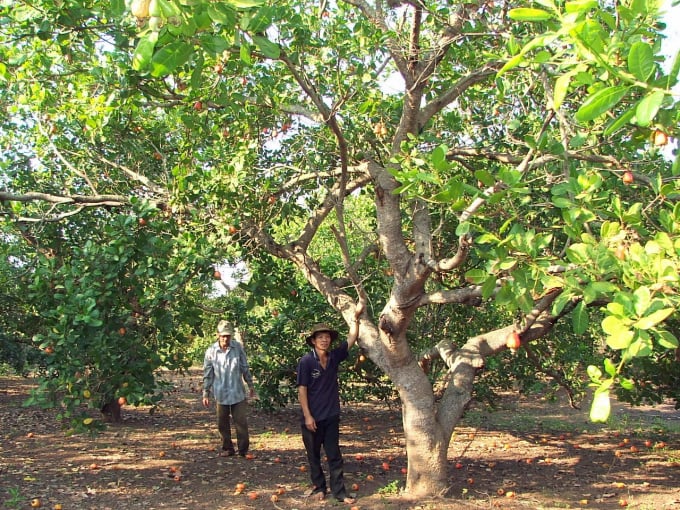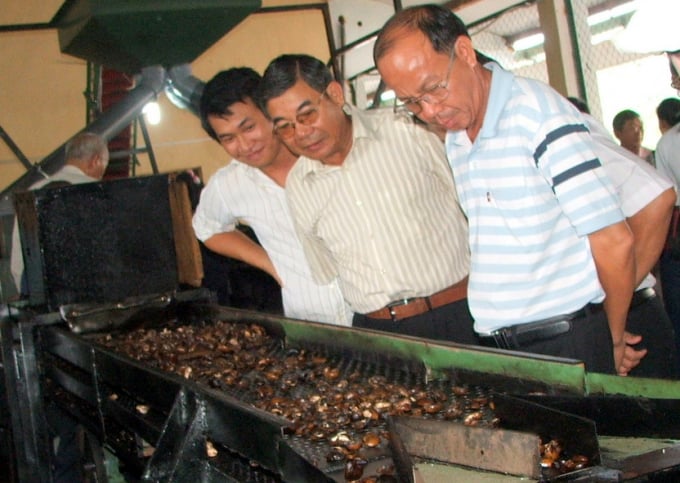Cashew growing in Binh Phuoc
According to Dr. Hoang Si Khai in the book “Main economic issues on developing cashew production in Vietnam” and Dr. Hoang Chuong in the book “Cashew growing techniques”, cashew trees appeared in Vietnam from the end of the 16th century to the beginning of the 17th century brought from Brazil by the Portuguese and Spanish.
In the 18th century, French doctor Alexandre Yersin also planted cashew trees on his farm in Vietnam. In addition, he also planted black pepper, carrots, cauliflower, chayote, gladiolus, hydrangea, lettuce, especially Ninh Thuan grapes, … which are temperate plants originating from France. Later, cashew trees grew very well in the Southeast region, the South Central Coast, … However, because the economic value of cashew trees was not fully recognized, and cashew trade was not yet developed, cashew trees were not a tree with a place on the map of key industrial crops in Vietnam at that time.

Cashew trees in Binh Phuoc.
According to Mr. Bay Thoa (Mr. Nguyen Van Thoa, former Vice Chairman of Binh Phuoc Provincial People’s Committee, Vice Chairman of Vietnam Cashew Association, Chairman of Binh Phuoc Cashew Association), in Phuoc Long province (old province), in 1956 – 1957, there were many people migrating from the North and Central regions, the Ngo Dinh Diem government established Dinh Dien to distribute 2 cans (1 can of jackfruit seeds, 1 can of peach seeds) to each household to use as seeds to build a home garden economy, to earn a living. This was part of the Ngo brothers’ policy to pacify the people. These two types of trees were planted together, the only thing was that when the cashew trees flowered and bore fruit, people only knew how to eat and play but did not know how to use them for anything.
After 1975, the South was completely liberated, in Phuoc Long at that time, ethnic people had the habit of moving and migrating, farmers burned forests to make fields. A few years later, the land was barren, and cogon grass grew everywhere. They abandoned their fields and went into the forest to cut down tall trees to make new fields. The forest gradually shrank until the government had a policy to encourage sedentary farming. In 1977-1978, some businesses bought cashews. Mr. Nguyen Dang Kinh (Mr. Bay Kinh was then the Secretary of the District Party Committee), Mr. Nguyen Tan Luc – Acting Chairman, and later Mr. Vo Dinh Tuyen – Chairman of the District People’s Committee had a policy to encourage people to “take the short-term to support the long-term” by planting cassava intercropped with cashew trees. The “resettlement” program at that time was a very new policy for the people. At first, the implementation encountered difficulties, but thanks to the initiative of the Youth Union (Mr. Bay Thoa was then the Secretary of the District Youth Union), the program achieved results. He said: “At that time, cashew planting was just digging holes to put seeds in, there was no special care technique, there was no fertilizer, and the seeds were not selected, but thanks to the fertile land, cashew planting still went well.” The policy of settling down, intercropping cashew with cassava, corn, etc. was initially implemented in the areas of the Stieng, Khmer, Mo Nong, K’Ho ethnic groups, etc., then spread to the Kinh residential areas. By 1989-1990, the cashew growing area in Phuoc Long had reached about 100,000 hectares. During this time, Vietnam’s cashew processing technology was officially born. However, Phuoc Long was only a locality that supplied raw cashews to other places. The district has established a number of cooperatives specializing in cashew trading such as Phuoc Binh Cooperative (where Mr. Tan and Khang are in charge), My Le facility in Phuoc Long town, Bu Gia Map Cooperative with Ms. Yen as Chairwoman, etc.
It was not until 1994 – 1995 that the district had Thanh Tam cashew factory invested by Mr. Thanh (Long An) and Mr. Tam. Before that, in 1991 in Thu Dau Mot, there was a cashew factory of Song Be Food Company with Mr. Vuong Hai as director, later transferred to Thanh Le Company (Thalexim). Phuoc Long later also had a fairly large factory, My Le Company – once the pride of the Party Committee and the people of Phuoc Long.

Mr. Nguyen Van Thoa (standing in the middle) during a visit to cashew shelling technology
According to Mr. Thoa, cashew cultivation not only contributes to the success of the Party and State’s policy of sedentarization in Binh Phuoc, but also contributes to stabilizing the lives of people in remote areas – where many ethnic minorities live; many families have become well-off; their children have received a good education; the face of the countryside has changed. In addition, cashew trees are also trees that regenerate the function of forests. Mr. Bay also shared that at first, farmers were only interested in large cashew nuts and many fruits, but did not know the rate of recovered kernels. Later, thanks to factories and processing technology, local cashew varieties were increasingly selected naturally. Currently, Binh Phuoc has many good varieties: large, plump and even seeds, with a recovery rate of up to 33, 34, 35%. Mr. Bay also explained why the cashew capital is in Binh Phuoc and not anywhere else: the land, soil, climate, weather and the character of the people here are very suitable for cashew trees, … – these things make Binh Phuoc cashew famous both domestically and internationally. He also said that the Binh Phuoc cashew industry is an industry with a fairly high level of industrialization and modernization. He is also the one who is contributing ideas to a resolution of the Binh Phuoc Provincial Party Committee on the direction of cashew development. In it, he proposed that there must be a policy to preserve the Binh Phuoc cashew brand, not to be confused with the cashew brand of other places such as African cashews. Because in fact, Binh Phuoc cashew has now become a national specialty tree. He also advised businesses in the province to build raw cashew areas in Cambodia and lower Laos because you still have a lot of land; moreover, you are looking to convert the land area for growing cassava to other crops. He also said that because of the land, climate and varieties, Cambodian cashews have many similarities with Vietnamese cashews; the two countries share a border, so cooperation in developing cashews in Cambodia is very good for both sides. He also shared with me a rather important piece of information that the Vietnam Rubber Industry Group is planning to change the land use purpose from rubber plantations to cashew and other crops.
The day I met him to get data to write this article, although he was retired and at the age of 75, he was still very clear-headed and always concerned about his homeland’s cashew trees.

When it comes to cashew trees in Binh Phuoc, there are many famous cashew growers such as Mr. Vo Minh Chien – a good cashew farmer in Bu Gia Map district. Mr. Chien has 117 hectares of cashew trees in Duc Hanh, Phu Van, and was once known as the “King of Cashews in Vietnam”.
Or, Mr. Duc Qui Dong, a person with a very good way of doing things; he does not have land to grow cashews but has the economy and capital, he rents land or enters into joint ventures with people who have land to grow cashews and then shares the products. Up to now, he has over 100 hectares of good cashew trees with high productivity in Bu Dop, Dong Phu, Phu Giao.
Or, Mr. Dieu Kem – a S’tieng ethnic person, residing in Bu Ka 2 hamlet, Long Ha commune, Phu Rieng district. He said: “Cashew trees have grown here since the time the State had a policy of “sedentarization”. Mr. Dieu Kem is a village elder, head of Bu Ka 2 hamlet. He is the Party cell secretary of Bu Ka 2 and Bu Mang 3 hamlets. He said that the cashew variety in this area is a local variety, the seeds are not very big but the seeds are even, the rate of recovery is high, the taste is delicious and fatty. Mr. Dieu Kem has a very special way to help his people grow cashews. When the cashew leaves fall and bloom, he advances capital and supplies, then he collects the cashews at market prices. He said that by doing so, the people do not suffer losses, and he also benefits because he has goods to deliver to the factory according to the contract. He also said “this is my responsibility because I am the village chief and have been the secretary here for many terms”.

Mr. Dieu Kem – a Stieng ethnic, a billionaire who got rich from cashew nuts. Photo: Binh Phuoc Online.
Mr. Nguyen Minh Trang is originally from the West in Soc Trang province. He went to Bom Bo to start a business after the liberation. He is a veteran and a good cashew farmer. A small house right next to Thac Mo Lake is where he and his wife live. He has a very special way of preserving the Bom Bo cashew variety. He said that when he was young, he specialized in gardening in his hometown, so grafting cashews was not difficult for him. He said: “For cashew trees, the variety is the most important”. He found that the Bom Bo cashew variety is a good variety (large seeds, full kernels, and delicious), so he encouraged people to be determined to preserve the precious variety for his homeland. In 2017, when our delegation visited him and returned, we visited several colleagues and cashew processors on the way back, all of whom confirmed that Bom Bo cashews are very good, so the market price is 1 – 2 thousand VND per kg higher than other places.
When it comes to Bom Bo, surely everyone knows the famous song by musician Xuan Hong during the anti-American war “The sound of pestles on Bom Bo’s hill”. Mr. Trang hopes that Bom Bo cashews will one day become as famous as the sound of rice pounding in the old hamlets. He established a new cooperative called “Thanh Phat Cooperative” with 147 members and over 700 hectares of cashews, all local varieties, large and even nuts, very high yield, and is producing organically. He boasted that he had just been re-elected by the villagers as Chairman of the Board of Directors and Director of the cooperative, but he was worried because he did not know how to help the villagers live well with cashew trees in the long term. I told him that he should find a production link with a decent cashew processing and export enterprise; he nodded, seeming very satisfied.



